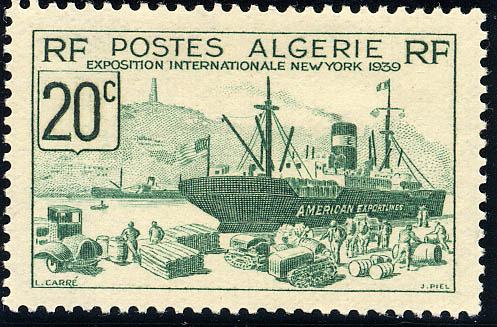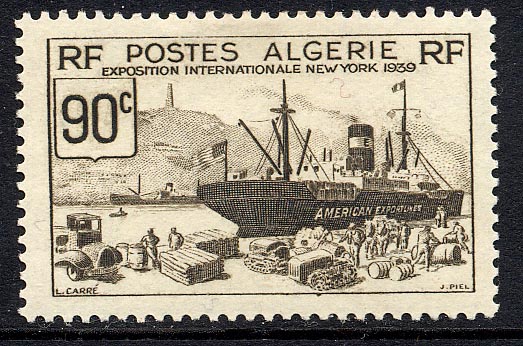Page 1 of 1
Extavia
Posted: Mon Dec 15, 2008 6:26 pm
by shipstamps


Some new information has been sent to me regarding the American Export Line's vessel on the set of stamps issued by Algeria to commemorate the Internation Exposition held in New York in 1939. It was given out, at the time of the stamp issue in Algiers, that the steamer alongside the quay was the Examiner, a ship which regularly visited Algiers and other Algerian ports from New York. It seems now however that the information about the vessel was incorrect. Capt. W. W. Kuhne, of the American Export Line, in a letter to a Sea Breezes reader Mr. H Rayl of Steubenville, Ohio, says that he was responsible for providing the Algerian Post Office with the original picture from which the stamp design was reproduced.
It was a photograph taken by Capt. Kuhne some years previously of the steamer Extavia discharging cargo at the quayside. She was one of the First World War ships built in 1919 at Hog Island and her original name was City of St. Joseph. She was similar in all respects to the Examiner from the same builders in the same year and perhaps this was the cause of the original error in giving out the sister-ship's name instead of the Extavia. The American Export Lines have perpetuated her name with a vessel built for them by the Bath Iron Works, Maine in 1941.
SG159-163 Sea Breezes 10/61
Re: Extavia
Posted: Wed Apr 11, 2012 6:27 pm
by D. v. Nieuwenhuijzen
Built in 1919 by American International Shipbuilding Corp. Hog Island Shipyard, Philadelphia for United States Shipping Board as CITY OF SAINT JOSEPH, cargoship, Gt:5591, Nt:4598, Dw:3453, Loa:118,87m. B:16,52m. draft:8,47m. 1 steamturbine, 11½ kn. 1924 assigned to Export Steamship Corp., 1925 purchasad, 1928 renamed EXTAVIA, 1941 renamed EXMOOR, 06-04-1942 sunk by gunfire of the Japanese heavy cruisers IJN KUMANO, IJN SUZUYA and the destroyer IJN SHIRAKUMO, in the Bay of Bengal.
(Navicula + internet)
Re: Extavia
Posted: Mon Jul 02, 2012 9:34 pm
by aukepalmhof
Built under yard No 1498 as a type A cargo vessel by American International Shipbuilding Corp. at Hog Island for the American Shipping Board.
June 1919 laid down under the name CLOVERDALE.
14 November 1919 launched as the CITY OF ST JOSEPH, christened by Miss Margaret Kemper Warner.
Tonnage 5,591 gross, 3,453 net, 7,800 dwt. Dim. 122.2 x 16.5 x 8.38m. length bpp. 118.9m.
Powered by a double reduction steam turbine engine manufactured by General Electric Co, 2,500 shp., speed maximum 11.5 knots.
Cargo capacity 373,220 cubic feet bale, 400,210 cubic feet grain.
Five holds, cargo handling equipment included 11 booms, with one heavy lift derrick of 30 ton.
31 December 1919 completed.
After delivery was she handed over to the Baltimore Oceanic Steamship Company, by this company was she used in the service between Baltimore and Norfolk to Genoa via Spanish and Portuguese ports.
06 January 1922 transferred to the related Mallory Transportation Company. Also used in the service from the USA to the Western Mediterranean.
When the Shipping Board decided to bring all her Mediterranean lines under one management, she was transferred on 15 November 1924 to the Export Steam Corporation.
1925 Bought by the Export Steam Corporation.
October 1928 Renamed by the company in EXTAVIA.
After the Export Steam Corporation signed a mail contract the EXTAVIA was fitted out with accommodation for 12 passengers.
January 1938 the owners name was changed to American Export Lines.
1941 Was she renamed in EXMOOR.
06 April 1942 on a voyage from Calcutta to Colombo loaded with 3,800 tons manganese ore , jute and gunnies she was shelled by Japanese gunfire from the heavy cruisers KUMANO and SUZUYA and the destroyer SHIRAKUMO in a position off Mahanadi Delta in the Bay of Bengal in position 19 52N 86 25E where after she sank. There were no causalities among the 37-men crew.
At the time of the attack the EXMOOR was unarmed, but sailed in a convoy.
Algeria 1939 20/2f50 sg159/163, scott126/130.
Source: The Hog Islanders by Mark H. Goldberg. Lloyds War Losses, The Second World War Volume I.
Lloyds Register 1934.

